
Electrostatics Experiments
These experiments require high voltages. Take great care if you
attempt to reproduce them and use a power source which has an output limited
to less than 100μA.
When polythene is rubbed with wool, some of the electrons in the
wool get transferred to the polythene. The polythene therefore becomes
negatively charged. It also follows that the wool must become
positively charged. If two pieces of polythene are rubbed with wool,
they will each become negatively charged and will repel each other
when brought together. Like charges repel and opposite charges
attract. Conductors can also carry a charge, but because the
charge carriers in a conductor are mobile, the charge is free
to redistribute.
If a charged conductor is irregularly shaped, the charge density (charge per
unit area) is not uniform. Charge density is highest at convex regions
of greatest curvature. Field strength is proportional to charge density.
It therefore follows that if you want a very high electric field strength
then you need a very sharp point and a high voltage. If you want to avoid
breakdown, then you need smooth surfaces.
Spinner
This experiment works in a similar way to a radiometer. Two sharp points are
mounted on a pivot so that they are free to move. A high voltage is applied,
which causes a very high electric field strength at the tips. Air molecules
which strike the tips are repelled away with increased kinetic energy. There
has to be an equal and opposite force into the tip and that causes it to move.
Without the air surrounding it, nothing would happen. I attempted to prove this
by operating a spinner inside a bell jar and then pumping the air out. As the
pressure dropped to around 0.1mbar the low pressure air broke down and forced
the EHT to drop to about 400V. I therefore had to turn the EHT off and use the
diffusion pump to get the pressure lower. When the pressure reached about
10-4mbar the EHT was switched back on and raised to 12kV. The
spinner didn't move.
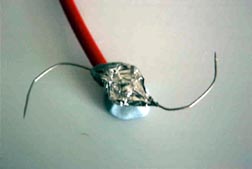 The spinner was made by bending two pins and soldering them to a small washer.
The washer was then wrapped in aluminium foil. A third pin, stood upright with
the point uppermost was used for the support. The support pin is pushed through
one layer of foil and slightly into the second layer. A small amount of Blu-Tack
was used to balance the spinner.
The spinner was made by bending two pins and soldering them to a small washer.
The washer was then wrapped in aluminium foil. A third pin, stood upright with
the point uppermost was used for the support. The support pin is pushed through
one layer of foil and slightly into the second layer. A small amount of Blu-Tack
was used to balance the spinner.
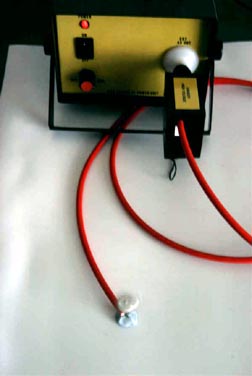 12kV was required to run the spinner. This was produced using a high voltage
power supply producing about 12kVrms at 15kHz, followed by a rectifier module.
The ac power supply is a home made unit which uses a b/w television flyback
transformer with a re-wound primary. This unit is very useful because voltage
multiplier networks can be added to produce even higher voltages. Instructions
on how to build this power supply can be found in the book 'Build Your Own
Infrared and Laser Space-Age Projects' by Robert E. Iannini.
12kV was required to run the spinner. This was produced using a high voltage
power supply producing about 12kVrms at 15kHz, followed by a rectifier module.
The ac power supply is a home made unit which uses a b/w television flyback
transformer with a re-wound primary. This unit is very useful because voltage
multiplier networks can be added to produce even higher voltages. Instructions
on how to build this power supply can be found in the book 'Build Your Own
Infrared and Laser Space-Age Projects' by Robert E. Iannini.
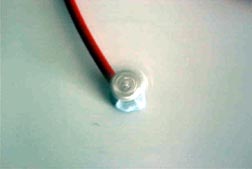 Here it can be seen spinning. It can easily be made to go at several thousand rpm.
Here it can be seen spinning. It can easily be made to go at several thousand rpm.
High Voltage Ping-Pong
This experiment uses the principal of electrostatic force to drive
conductive balls up and down a tube.
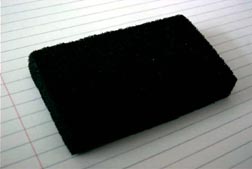 To make the balls I used black conductive foam. This material is
commonly used for storing integrated circuits. The foam was cut
into four cubes, each about a centimeter square. The corners were then
cut off of the cubes to make them approximately spherical. Solid
metal balls will not work because their mass is too high.
To make the balls I used black conductive foam. This material is
commonly used for storing integrated circuits. The foam was cut
into four cubes, each about a centimeter square. The corners were then
cut off of the cubes to make them approximately spherical. Solid
metal balls will not work because their mass is too high.
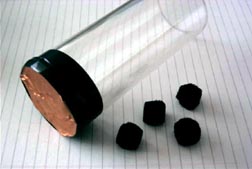 The plastic tube used is 115mm long and 45mm in diameter. The longer the
tube, the higher the voltage that is required. The conductive end caps
on the tube were made from copper mesh. Just about any conductive sheet
can be used for the end caps, but it must be possible to attach wires
to it. The end caps were attached to the tube with insulating tape.
The plastic tube used is 115mm long and 45mm in diameter. The longer the
tube, the higher the voltage that is required. The conductive end caps
on the tube were made from copper mesh. Just about any conductive sheet
can be used for the end caps, but it must be possible to attach wires
to it. The end caps were attached to the tube with insulating tape.
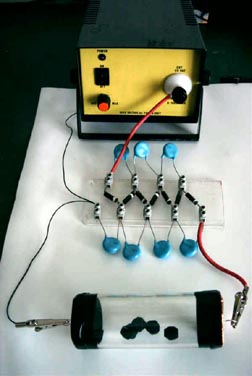 35kV was required to operate the experiment. This was obtained by
using the ac EHT supply followed by a Cockcroft-Walton voltage
multiplier network.
35kV was required to operate the experiment. This was obtained by
using the ac EHT supply followed by a Cockcroft-Walton voltage
multiplier network.
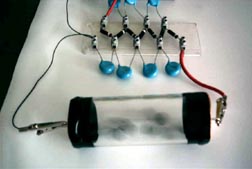 Here the balls can be seen shooting up and down. A slight incline
on the tube seems to help to prevent the balls getting stuck in the
middle.
Here the balls can be seen shooting up and down. A slight incline
on the tube seems to help to prevent the balls getting stuck in the
middle.
 The spinner was made by bending two pins and soldering them to a small washer.
The washer was then wrapped in aluminium foil. A third pin, stood upright with
the point uppermost was used for the support. The support pin is pushed through
one layer of foil and slightly into the second layer. A small amount of Blu-Tack
was used to balance the spinner.
The spinner was made by bending two pins and soldering them to a small washer.
The washer was then wrapped in aluminium foil. A third pin, stood upright with
the point uppermost was used for the support. The support pin is pushed through
one layer of foil and slightly into the second layer. A small amount of Blu-Tack
was used to balance the spinner.
 12kV was required to run the spinner. This was produced using a high voltage
power supply producing about 12kVrms at 15kHz, followed by a rectifier module.
The ac power supply is a home made unit which uses a b/w television flyback
transformer with a re-wound primary. This unit is very useful because voltage
multiplier networks can be added to produce even higher voltages. Instructions
on how to build this power supply can be found in the book 'Build Your Own
Infrared and Laser Space-Age Projects' by Robert E. Iannini.
12kV was required to run the spinner. This was produced using a high voltage
power supply producing about 12kVrms at 15kHz, followed by a rectifier module.
The ac power supply is a home made unit which uses a b/w television flyback
transformer with a re-wound primary. This unit is very useful because voltage
multiplier networks can be added to produce even higher voltages. Instructions
on how to build this power supply can be found in the book 'Build Your Own
Infrared and Laser Space-Age Projects' by Robert E. Iannini. Here it can be seen spinning. It can easily be made to go at several thousand rpm.
Here it can be seen spinning. It can easily be made to go at several thousand rpm. To make the balls I used black conductive foam. This material is
commonly used for storing integrated circuits. The foam was cut
into four cubes, each about a centimeter square. The corners were then
cut off of the cubes to make them approximately spherical. Solid
metal balls will not work because their mass is too high.
To make the balls I used black conductive foam. This material is
commonly used for storing integrated circuits. The foam was cut
into four cubes, each about a centimeter square. The corners were then
cut off of the cubes to make them approximately spherical. Solid
metal balls will not work because their mass is too high. The plastic tube used is 115mm long and 45mm in diameter. The longer the
tube, the higher the voltage that is required. The conductive end caps
on the tube were made from copper mesh. Just about any conductive sheet
can be used for the end caps, but it must be possible to attach wires
to it. The end caps were attached to the tube with insulating tape.
The plastic tube used is 115mm long and 45mm in diameter. The longer the
tube, the higher the voltage that is required. The conductive end caps
on the tube were made from copper mesh. Just about any conductive sheet
can be used for the end caps, but it must be possible to attach wires
to it. The end caps were attached to the tube with insulating tape. 35kV was required to operate the experiment. This was obtained by
using the ac EHT supply followed by a Cockcroft-Walton voltage
multiplier network.
35kV was required to operate the experiment. This was obtained by
using the ac EHT supply followed by a Cockcroft-Walton voltage
multiplier network. Here the balls can be seen shooting up and down. A slight incline
on the tube seems to help to prevent the balls getting stuck in the
middle.
Here the balls can be seen shooting up and down. A slight incline
on the tube seems to help to prevent the balls getting stuck in the
middle.